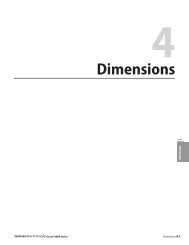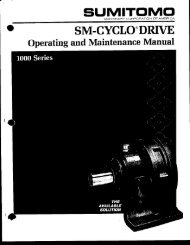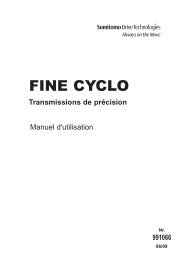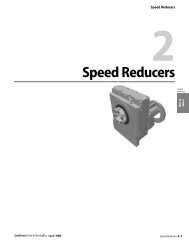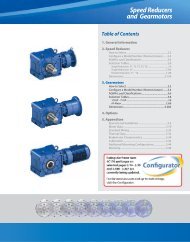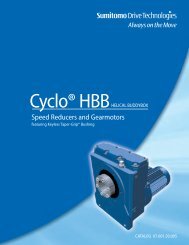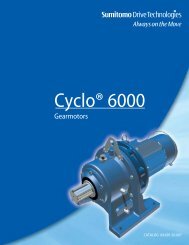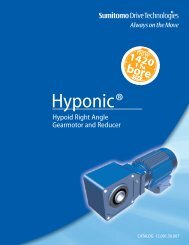Cyclo® 6000 - Sumitomo Drive Technologies
Cyclo® 6000 - Sumitomo Drive Technologies
Cyclo® 6000 - Sumitomo Drive Technologies
Create successful ePaper yourself
Turn your PDF publications into a flip-book with our unique Google optimized e-Paper software.
Speed<br />
Reducers<br />
Overhung<br />
Loads<br />
CYCLO® <strong>6000</strong> Speed Reducers<br />
Overhung Loads • Slow Speed Shaft<br />
Overhung Loads are loads that act perpendicular to the reducer shaft. Each reducer has a maximum allowable overhung load (OHL)<br />
capacity, which is shown in the Frame Size Selection Tables for each reducer. In applications with an OHL, it is critical that the OHL is calculated<br />
and that the chosen reducer is adequately sized for the maximum OHL.<br />
5.6 Technical Information<br />
How to Calculate Overhung Load (OHL)<br />
Step 1. Measure distance X from reducer collar surface<br />
to the centerline of the OHL.<br />
Step 2. Determine Lf (Load Location Factor) for your chosen Frame Size,<br />
using Load Location Factor Table on the next page.<br />
Step 3. Determine Cf (Connection Factor) and Sf (Shock Factor) from the tables below:<br />
Load Connection Factor (Cf)<br />
CONNECTION TYPE FACTOR<br />
General Purpose Chain 1.0<br />
Machined Gear or Synchronous Belt 1.25<br />
V-Belt 1.5<br />
Flat Belt 2.5<br />
Step 4. Apply Lf, Cf and Sf to the formula to calculate the OHL.<br />
EXAMPLE: Known HP = Power Transmitted by shaft (HP)<br />
Known D = Pitch Diameter of sprocket (inches)<br />
Known N = Shaft Speed (RPM)<br />
Centerline of Load<br />
Step 5. Refer back to the Frame Size Selection Tables (pp. 3.1–3.32) to determine maximum<br />
allowable OHL capacity for the selected Frame Size.<br />
If the calculated OHL does not exceed the OHL capacity (from Selection Table),<br />
the selected Frame Size is acceptable.<br />
If the calculated OHL exceeds the OHL capacity, there are two standard options<br />
that can increase the OHL capacity of a reducer:<br />
• High Capacity Bearings Option–R1 (Table on pg. 5.8)<br />
• Ductile Iron Housing & High Capacity Bearings Option–R2 (Table on pg. 5.9)<br />
If neither of these options adequately increase the OHL capacity:<br />
1. Choose the next larger Frame Size, or<br />
2. Move the OHL closer to the collar surface, or<br />
3. Decrease the OHL by increasing the pitch diameter of the connecting drive.<br />
Be sure to recalculate and verify the OHL capacity for the new frame size.<br />
X<br />
Collar<br />
Surface<br />
Service Factor (Sf)<br />
DEGREE OF SHOCK FACTOR<br />
Steady Loads 1.0<br />
Moderate Shock 1.3<br />
Heavy Shock 1.6<br />
126,000 x HP X Lf X Cf X Sf = Calculated OHL<br />
D X N<br />
<strong>Cyclo®</strong> <strong>6000</strong> Series



